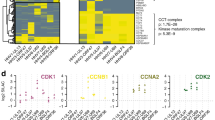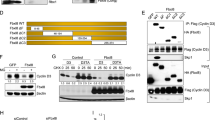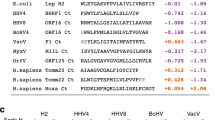Abstract
v-cyclin encoded by Kaposi's sarcoma herpesvirus/human herpesvirus 8 (KSHV or HHV8) associates with cellular cyclin-dependent kinase 6 (CDK6) to form a kinase complex that promotes cell-cycle progression, but can also induce apoptosis in cells with high levels of CDK6. Here we show that whereas HHV8-encoded v-Bcl-2 protects against this apoptosis, cellular Bcl-2 has lost its anti-apoptotic potential as a result of an inactivating phosphorylation in its unstructured loop region. Moreover, we identify Bcl-2 as a new substrate for v-cyclin–CDK6 in vitro, and show that it is present in a complex with CDK6 in cell lysates. A Bcl-2 mutant with a S70A S87A double substitution in the loop region is not phosphorylated and provides resistance to apoptosis, indicating that inactivation of Bcl-2 by v-cyclin–CDK6 may be required for the observed apoptosis. Furthermore, the identification of phosphorylated Bcl-2 in HHV8-positive Kaposi's sarcoma indicates that HHV8-mediated interference with host apoptotic signalling pathways may encourage the development of Kaposi's sarcoma.
This is a preview of subscription content, access via your institution
Access options
Subscribe to this journal
Receive 12 print issues and online access
$209.00 per year
only $17.42 per issue
Buy this article
- Purchase on Springer Link
- Instant access to full article PDF
Prices may be subject to local taxes which are calculated during checkout






Similar content being viewed by others
References
Cannell, E. & Mittnacht, S. Viral encoded cyclins. Semin. Cancer Biol. 9, 221–229 (1999).
Godden-Kent, D. et al. The cyclin encoded by Kaposi's sarcoma-associated herpesvirus stimulates cdk6 to phosphorylate the retinoblastoma protein and histone H1. J. Virol. 71, 4193–4198 (1997).
Li, M. et al. Kaposi's sarcoma-associated herpesvirus encodes a functional cyclin. J. Virol. 71, 1984–1991 (1997).
Swanton, C. et al. Herpes viral cyclin/Cdk6 complexes evade inhibition by CDK inhibitor proteins. Nature 390, 184–187 (1997).
Ellis, M. et al. Degradation of p27(Kip) cdk inhibitor triggered by Kaposi's sarcoma virus cyclin-cdk6 complex. EMBO J. 18, 644–653 (1999).
Mann, D. J., Child, E. S., Swanton, C., Laman, H. & Jones, N. Modulation of p27(Kip1) levels by the cyclin encoded by Kaposi's sarcoma-associated herpesvirus. EMBO J. 18, 654–663 (1999).
Ojala, P. M. et al. Kaposi's sarcoma-associated herpesvirus-encoded v-cyclin triggers apoptosis in cells with high levels of cyclin-dependent kinase 6. Cancer Res. 59, 4984–4989 (1999).
Friborg, J. Jr et al. Distinct biology of Kaposi's sarcoma-associated herpesvirus from primary lesions and body cavity lymphomas. J. Virol. 72, 10073–10082 (1998).
Kaaya, E. et al. Proliferation and apoptosis in the evolution of endemic and acquired immunodeficiency syndrome-related Kaposi's sarcoma. Med. Oncol. (in the press).
Kranenburg, O., van der Eb, A. J. & Zantema, A. Cyclin D1 is an essential mediator of apoptotic neuronal cell death. EMBO J. 15, 46–54 (1996).
Sofer-Levi, Y. & Resnitzky, D. Apoptosis induced by ectopic expression of cyclin D1 but not cyclin E. Oncogene 13, 2431–2437 (1996).
Meikrantz, W. & Schlegel, R. Suppression of apoptosis by dominant negative mutants of cyclin- dependent protein kinases. J. Biol. Chem. 271, 10205–10209 (1996).
Gil-Gomez, G., Berns, A. & Brady, H. J. A link between cell cycle and cell death: Bax and Bcl-2 modulate Cdk2 activation during thymocyte apoptosis. EMBO J. 17, 7209–7218 (1998).
Dobashi, Y. et al. A novel apoptotic cascade mediated by CDK4 in rat pheochromocytoma PC12 cells. Biochem. Biophys. Res. Commun. 260, 806–812 (1999).
Cheng, E. H. et al. A Bcl-2 homolog encoded by Kaposi sarcoma-associated virus, human herpesvirus 8, inhibits apoptosis but does not heterodimerize with Bax or Bak. Proc. Natl Acad. Sci. USA 94, 690–694 (1997).
Sarid, R., Sato, T., Bohenzky, R. A., Russo, J. J. & Chang, Y. Kaposi's sarcoma-associated herpesvirus encodes a functional bcl-2 homologue. Nature Med. 3, 293–298 (1997).
Gross, A., McDonnell, J. M. & Korsmeyer, S. J. BCL-2 family members and the mitochondria in apoptosis. Genes Dev. 13, 1899–1911 (1999).
Adams, J. M. & Cory, S. The Bcl-2 protein family: arbiters of cell survival. Science 281, 1322–1326 (1998).
Haldar, S., Jena, N. & Croce, C. M. Inactivation of Bcl-2 by phosphorylation. Proc. Natl Acad. Sci. USA 92, 4507–4511 (1995).
Poommipanit, P. B., Chen, B. & Oltvai, Z. N. Interleukin-3 induces the phosphorylation of a distinct fraction of bcl- 2. J. Biol. Chem. 274, 1033–1039 (1999).
Reed, J. C. Bcl-2 family proteins: strategies for overcoming chemoresistance in cancer. Adv. Pharmacol. 41, 501–532 (1997).
Haldar, S., Chintapalli, J. & Croce, C. M. Taxol induces bcl-2 phosphorylation and death of prostate cancer cells. Cancer Res. 56, 1253–1255 (1996).
Blagosklonny, M. V., Schulte, T., Nguyen, P., Trepel, J. & Neckers, L. M. Taxol-induced apoptosis and phosphorylation of Bcl-2 protein involves c-Raf-1 and represents a novel c-Raf-1 signal transduction pathway. Cancer Res. 56, 1851–1854 (1996).
Yamamoto, K., Ichijo, H. & Korsmeyer, S. J. BCL-2 is phosphorylated and inactivated by an ASK1/Jun N-terminal protein kinase pathway normally activated at G(2)/M. Mol. Cell Biol. 19, 8469–8478 (1999).
May, W. S. et al. Interleukin-3 and bryostatin-1 mediate hyperphosphorylation of BCL2 alpha in association with suppression of apoptosis. J. Biol. Chem. 269, 26865–26870 (1994).
Ito, T., Deng, X., Carr, B. & May, W. S. Bcl-2 phosphorylation required for anti-apoptosis function. J. Biol. Chem. 272, 11671–11673 (1997).
Ruvolo, P. P., Deng, X., Carr, B. K. & May, W. S. A functional role for mitochondrial protein kinase C alpha in Bcl2 phosphorylation and suppression of apoptosis. J. Biol. Chem. 273, 25436–25442 (1998).
Ueno, H. et al. Association of insulin receptor substrate proteins with Bcl-2 and their effects on its phosphorylation and antiapoptotic function. Mol. Biol. Cell 11, 735–746 (2000).
Maundrell, K. et al. Bcl-2 undergoes phosphorylation by c-Jun N-terminal kinase/stress-activated protein kinases in the presence of the constitutively active GTP-binding protein Rac1. J. Biol. Chem. 272, 25238–25242 (1997).
Blagosklonny, M. V. et al. Raf-1/bcl-2 phosphorylation: a step from microtubule damage to cell death. Cancer Res. 57, 130–135 (1997).
Srivastava, R. K. et al. Involvement of microtubules in the regulation of Bcl2 phosphorylation and apoptosis through cyclic AMP-dependent protein kinase. Mol. Cell. Biol. 18, 3509–3517 (1998).
Ling, Y. H., Tornos, C. & Perez-Soler, R. Phosphorylation of Bcl-2 is a marker of M phase events and not a determinant of apoptosis. J. Biol. Chem. 273, 18984–18991 (1998).
Scatena, C. D. et al. Mitotic phosphorylation of Bcl-2 during normal cell cycle progression and taxol-induced growth arrest. J. Biol. Chem. 273, 30777–30784 (1998).
Alnemri, E. S., Robertson, N. M., Fernandes, T. F., Croce, C. M. & Litwack, G. Overexpressed full-length human BCL2 extends the survival of baculovirus-infected Sf9 insect cells. Proc. Natl Acad. Sci. USA 89, 7295–7299 (1992).
Chang, B. S., Minn, A. J., Muchmore, S. W., Fesik, S. W. & Thompson, C. B. Identification of a novel regulatory domain in Bcl-X(L) and Bcl-2. EMBO J. 16, 968–977 (1997).
Fang, G. et al. `Loop' domain is necessary for taxol-induced mobility shift and phosphorylation of Bcl-2 as well as for inhibiting taxol-induced cytosolic accumulation of cytochrome c and apoptosis. Cancer Res. 58, 3202–3208 (1998).
Haldar, S., Basu, A. & Croce, C. M. Serine-70 is one of the critical sites for drug-induced Bcl2 phosphorylation in cancer cells. Cancer Res. 58, 1609–1615 (1998).
Srivastava, R. K., Mi, Q. S., Hardwick, J. M. & Longo, D. L. Deletion of the loop region of Bcl-2 completely blocks paclitaxel- induced apoptosis. Proc. Natl Acad. Sci. USA 96, 3775–3780 (1999).
Chan, S. R., Bloomer, C. & Chandran, B. Identification and characterization of human herpesvirus-8 lytic cycle-associated ORF 59 protein and the encoding cDNA by monoclonal antibody. Virology 240, 118–126 (1998).
Hoang, A. T., Cohen, K. J., Barrett, J. F., Bergstrom, D. A. & Dang, C. V. Participation of cyclin A in Myc-induced apoptosis. Proc. Natl Acad. Sci. USA 91, 6875–6879 (1994).
Hardwick, J. M. Viral interference with apoptosis. Semin. Cell Dev. Biol. 9, 339–349 (1998).
Strack, P. R. et al. Apoptosis mediated by HIV protease is preceded by cleavage of Bcl-2. Proc. Natl Acad. Sci. USA 93, 9571–9576 (1996).
Grandgirard, D. et al. Alphaviruses induce apoptosis in Bcl-2-overexpressing cells: evidence for a caspase-mediated, proteolytic inactivation of Bcl-2. EMBO J. 17, 1268–1278 (1998).
Sastry, K. J. et al. Expression of human immunodeficiency virus type I tat results in down-regulation of bcl-2 and induction of apoptosis in hematopoietic cells. Oncogene 13, 487–493 (1996).
Aillet, F. et al. Human immunodeficiency virus induces a dual regulation of Bcl-2, resulting in persistent infection of CD4(+) T- or monocytic cell lines. J. Virol. 72, 9698–9705 (1998).
Hinds, P. W. et al. Regulation of retinoblastoma protein functions by ectopic expression of human cyclins. Cell 70, 993–1006 (1992).
Platt, G. M., Cannell, E., Cuomo, M. E., Singh, S. & Mittnacht, S. Detection of the human herpesvirus 8-encoded cyclin protein in primary effusion lymphoma-derived cell lines. Virology 272, 257–266 (2000).
Arvanitakis, L. et al. Establishment and characterization of a primary effusion (body cavity-based) lymphoma cell line (BC-3) harboring kaposi's sarcoma-associated herpesvirus (KSHV/HHV-8) in the absence of Epstein–Barr virus. Blood 88, 2648–2654 (1996).
Leppa, S., Saffrich, R., Ansorge, W. & Bohmann, D. Differential regulation of c-Jun by ERK and JNK during PC12 cell differentiation. EMBO J. 17, 4404–4413 (1998).
Matsushime, H. et al. D-type cyclin-dependent kinase activity in mammalian cells. Mol. Cell Biol. 14, 2066–2076 (1994).
Acknowledgements
We thank N. Kalkkinen and J. Helin for the MALDI-TOF analysis, and E. E. Kaaya and C. Massambu (Muhimbili Univ. College, Dar-es-Salam, Tanzania) for the Kaposi's sarcoma biopsy material. We are also grateful to E. Cesarman, M. Hardwick, C. Sherr, S. Mittnacht, B. Chandran, L. Andersson, P. Moore, Y. Chang, S. Leppä and M. Eriksson for reagents, M. Schoultz for help with fluorescence-activated cell-sorter analysis, and members of the Mäkelä laboratory for discussions and suggestions. B. Tjäder provided excellent technical assistance. This study was supported by grants from the Academy of Finland, Univ. Helsinki, Helsinki Univ. Central Hospital EVO funds, Finnish Cancer Society, Finnish Cancer Institute, Sigrid Juselius Foundation, and the BIOMED-2 Concerted Action (CA) on the `Pathogenesis of AIDS Kaposi's sarcoma' (contract no. BMH4-97-2302).
Author information
Authors and Affiliations
Corresponding author
Rights and permissions
About this article
Cite this article
Ojala, P., Yamamoto, K., Castaños-Vélez, E. et al. The apoptotic v-cyclin–CDK6 complex phosphorylates and inactivates Bcl-2. Nat Cell Biol 2, 819–825 (2000). https://doi.org/10.1038/35041064
Received:
Revised:
Accepted:
Published:
Issue Date:
DOI: https://doi.org/10.1038/35041064
This article is cited by
-
CDK4/6 inhibitors sensitize gammaherpesvirus-infected tumor cells to T-cell killing by enhancing expression of immune surface molecules
Journal of Translational Medicine (2022)
-
Cyclin-dependent kinases and CDK inhibitors in virus-associated cancers
Infectious Agents and Cancer (2020)
-
Cdk2 phosphorylation of Bcl-xL after stress converts it to a pro-apoptotic protein mimicking Bax/Bak
Cell Death Discovery (2016)
-
Multifaceted Roles of the Viral Cyclin in Gammaherpesvirus Pathogenesis
Current Clinical Microbiology Reports (2016)
-
Disruption of Bcl-2 and Bcl-xL by viral proteins as a possible cause of cancer
Infectious Agents and Cancer (2014)



